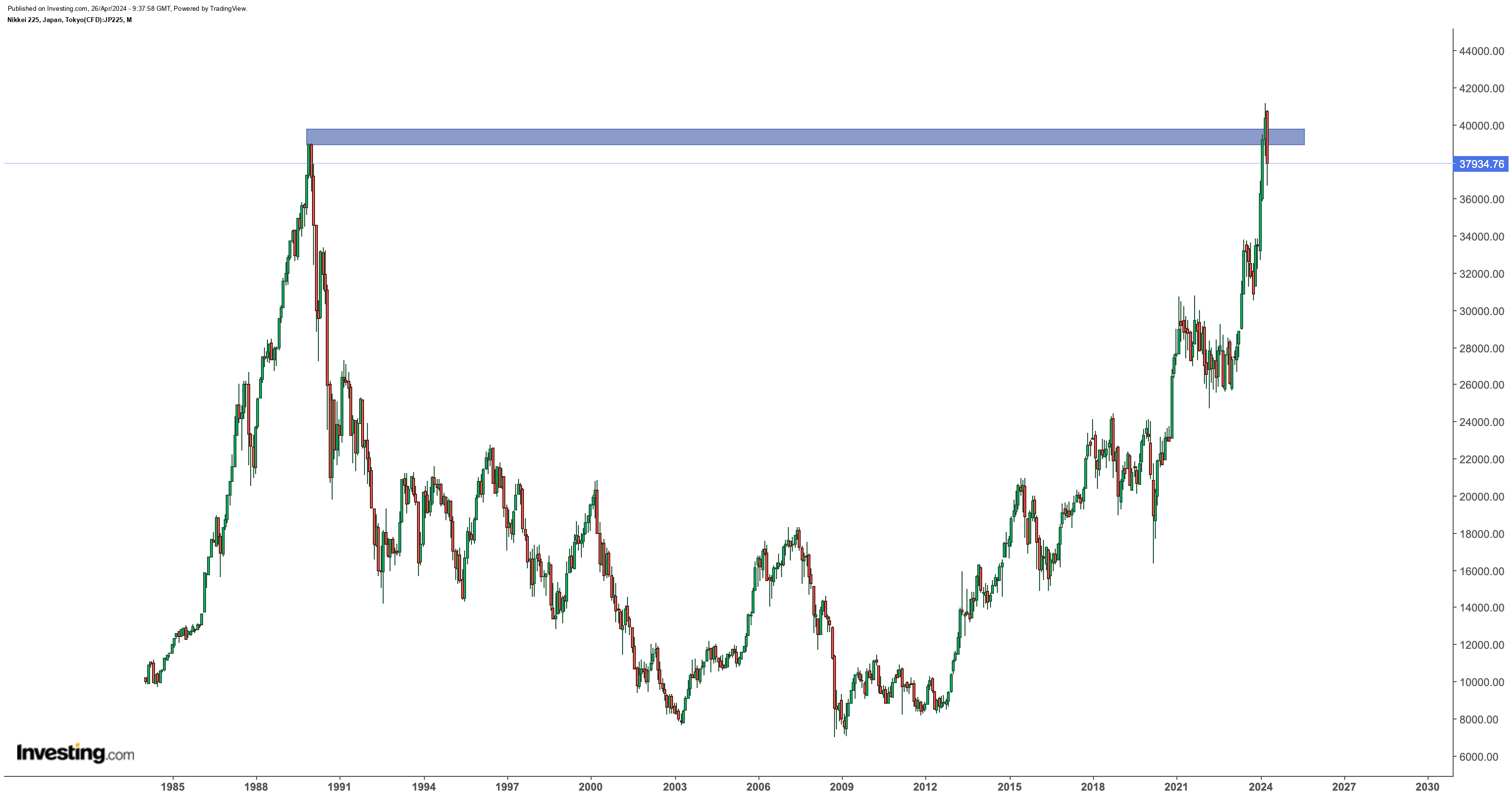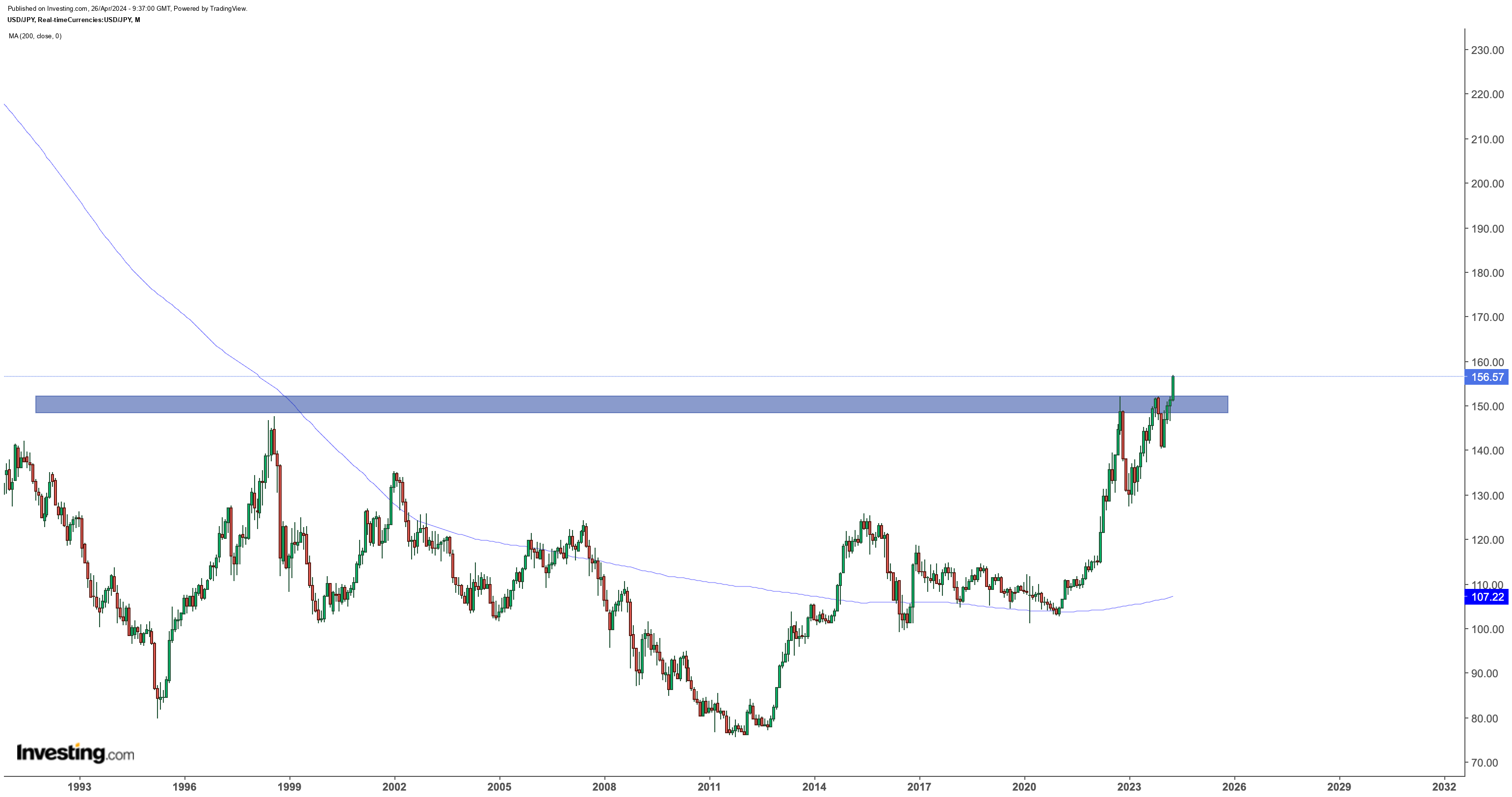- BoJ has kept rates near zero, following which the yen tumbled to 34-year low against US dollar.
- A weaker yen could boost exporters but hurt consumers, stoking intervention fears.
- For the USD/JPY, 157 level could be in the cards if BoJ does not intervene soon enough.
- For less than $9 a month, access our AI-powered ProPicks stock selection tool. Learn more here>>
Japan's central bank has maintained a cautious stance despite its recent interest rate policy adjustments. This morning, the Monetary Policy Committee of the Bank of Japan (BoJ) elected to retain the key interest rate at zero to 0.1% for the foreseeable future. This decision, although widely anticipated by financial markets, provided an opportunity for traders to further devalue the currency, particularly against a stronger US dollar.
The aftermath saw the USD/JPY exchange rate surge to over 156 yen, marking its weakest level in 34 years. This perpetuates the ongoing trend of yen depreciation, despite admonitions against exchange rate intervention issued by the Japanese Ministry of Finance.
According to ING, "There has been nothing from the BoJ today to provide much immediate support for the Yen - hence USD/JPY is pushing to new highs above 156. This begs the question of if and when Japanese authorities will intervene."
In his press conference after the meeting, BoJ Governor Kazuo Ueda noted that the probability of prolonged JPY weakness is not zero.
Japan's Finance Minister Shunichi Suzuki also reiterated that he is closely monitoring currency fluctuations and is prepared to "take all necessary measures when needed", although he declined to comment on the specifics of the policy.
The substantial devaluation of the Japanese currency has reignited already concerns within the Japan-United States relationship.
Despite such concerns, market forces persist in driving the yen's depreciation.
A Weakened Yen and Export Profitability
While central banks worldwide have aggressively raised interest rates in the last two years to combat inflation, the BoJ adhered to its negative interest rate policy until March. However, the widening interest rate differential precipitated a significant depreciation of the yen against the dollar and euro in foreign exchange markets.
Historically, the central bank defended the yen's exchange rate by highlighting its positive implications for the economy. Notably, a weaker yen bolsters the profits of export-oriented companies through enhanced overseas earnings conversion.
This favorable dynamic contributed to record-breaking performances on the stock market, with the Nikkei 225 index surpassing its previous peak from the 1980s bubble era.

Nonetheless, as the yen's depreciation persisted, adverse effects on the domestic economy and consumers became increasingly apparent.
Revised Growth Projections and Monetary Policy Outlook
In light of these developments, speculation surrounding a potential interest rate hike by the BoJ mounts as a prospective measure to stem or reverse yen depreciation. However, analysts anticipate that the central bank may defer such actions until December.
The BoJ's quarterly report on economic and price developments, unveiled concurrently, yields mixed signals. Notably, the Monetary Policy Committee revised downward its growth forecast for the recently concluded fiscal year 2023 from 1.8% to 1.3%, and for 2024 from 1.2% to 0.8%.
Conversely, inflation forecasts for the current year were upwardly revised from 2.4% to 2.8%, exceeding the two percent target. However, projections for 2025 only saw a marginal increase from 1.8% to 1.9%.
Government data on Friday showed that Tokyo's consumer inflation slowed sharply in April, undermining the Japanese Yen along with the Bank of Japan's decision to maintain the status quo. Tokyo's headline consumer price index (CPI) rose 1.8 % year-on-year in April, while core CPI (excluding fresh food and energy) rose 1.8 % in the month, both missing consensus estimates. The core CPI, which excludes both fresh food and energy prices and is closely watched by the BoJ as a measure of underlying inflation, fell below the 2 % target for the first time since September 2022.
The confluence of weakening growth and persistent low inflation suggests a gradual approach to interest rate adjustments by the central bank. Bank of America (NYSE:BAC) strategists foresee a potential interest rate hike to 0.25 % by December, followed by two subsequent increments in 2025. Consequently, the Japanese yen may encounter further volatility in the coming months, albeit with the specter of Bank of Japan intervention looming in tandem with its ascent.
Technical Analysis
The USD/JPY's recent breach of the critical resistance zone at 152 JPY represented a pivotal breakthrough, as this level has historically held significance since the 1980s. This breach culminates in a substantial bottom formation, auguring well for further upward momentum. Moreover, the breakout from the bullish ascending triangle formation since autumn 2022 lends further credence to this positive outlook.
Anticipated follow-through potential approximates a gain of over 15 JPY, with the April 1990 high at JPY 160 serving as a significant milestone along this trajectory. Conversely, downside risk is mitigated by the support provided by the breakout level.

Conclusion
In conclusion, Japan's central bank finds itself at the nexus of intersecting economic forces, balancing the imperatives of export-driven growth with the imperative of domestic economic stability.
As market participants await the BoJ's next move, the trajectory of the yen and its broader implications for Japan's economic landscape remain subjects of intense scrutiny and speculation, underscoring the pivotal role of prudent monetary policy in navigating uncertain terrain.
***
Take your investing game to the next level in 2024 with ProPicks
Institutions and billionaire investors worldwide are already well ahead of the game when it comes to AI-powered investing, extensively using, customizing, and developing it to bulk up their returns and minimize losses.
Now, InvestingPro users can do just the same from the comfort of their own homes with our new flagship AI-powered stock-picking tool: ProPicks.
With our six strategies, including the flagship "Tech Titans," which outperformed the market by a lofty 1,745% over the last decade, investors have the best selection of stocks in the market at the tip of their fingers every month.
Subscribe here and never miss a bull market again!
Disclaimer: This content, which is prepared purely for educational purposes, cannot be considered as investment advice. We also do not provide investment advisory services.

